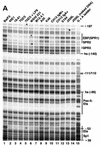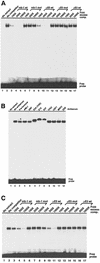Early B-cell factor, E2A, and Pax-5 cooperate to activate the early B cell-specific mb-1 promoter
- PMID: 12446773
- PMCID: PMC139876
- DOI: 10.1128/MCB.22.24.8539-8551.2002
Early B-cell factor, E2A, and Pax-5 cooperate to activate the early B cell-specific mb-1 promoter
Abstract
Previous studies have suggested that the early-B-cell-specific mb-1(Igalpha) promoter is regulated by EBF and Pax-5. Here, we used in vivo footprinting assays to detect occupation of binding sites in endogenous mb-1 promoters at various stages of B-cell differentiation. In addition to EBF and Pax-5 binding sites, we detected occupancy of a consensus binding site for E2A proteins (E box) in pre-B cells. EBF and E box sites are crucial for promoter function in transfected pre-B cells, and EBF and E2A proteins synergistically activated the promoter in transfected HeLa cells. Other data suggest that EBF and E box sites are less important for promoter function at later stages of differentiation, whereas binding sites for Pax-5 (and its Ets ternary complex partners) are required for promoter function in all mb-1-expressing cells. Using DNA microarrays, we found that expression of endogenous mb-1 transcripts correlates most closely with EBF expression and negatively with Id1, an inhibitor of E2A protein function, further linking regulation of the mb-1 gene with EBF and E2A. Together, our studies demonstrate the complexity of factors regulating tissue-specific transcription and support the concept that EBF, E2A, and Pax-5 cooperate to activate target genes in early B-cell development.
Figures










Similar articles
-
Coordinate regulation of B cell differentiation by the transcription factors EBF and E2A.Immunity. 1999 Jul;11(1):21-31. doi: 10.1016/s1074-7613(00)80078-3. Immunity. 1999. PMID: 10435576
-
Pax-5 (BSAP) recruits Ets proto-oncogene family proteins to form functional ternary complexes on a B-cell-specific promoter.Genes Dev. 1996 Sep 1;10(17):2198-211. doi: 10.1101/gad.10.17.2198. Genes Dev. 1996. PMID: 8804314
-
Induction of early B cell factor (EBF) and multiple B lineage genes by the basic helix-loop-helix transcription factor E12.J Exp Med. 1998 Aug 17;188(4):699-713. doi: 10.1084/jem.188.4.699. J Exp Med. 1998. PMID: 9705952 Free PMC article.
-
The role of BSAP (Pax-5) in B-cell development.Curr Opin Genet Dev. 1995 Oct;5(5):595-601. doi: 10.1016/0959-437x(95)80028-x. Curr Opin Genet Dev. 1995. PMID: 8664547 Review.
-
Roles of EBF and Pax-5 in B lineage commitment and development.Semin Immunol. 2002 Dec;14(6):415-22. doi: 10.1016/s1044532302000763. Semin Immunol. 2002. PMID: 12457614 Review.
Cited by
-
Diverse roles of inhibitor of differentiation 2 in adaptive immunity.Clin Dev Immunol. 2011;2011:281569. doi: 10.1155/2011/281569. Epub 2011 Mar 17. Clin Dev Immunol. 2011. PMID: 21437223 Free PMC article. Review.
-
Dynamic EBF1 occupancy directs sequential epigenetic and transcriptional events in B-cell programming.Genes Dev. 2018 Jan 15;32(2):96-111. doi: 10.1101/gad.309583.117. Epub 2018 Feb 9. Genes Dev. 2018. PMID: 29440261 Free PMC article.
-
The regulatory network of B-cell differentiation: a focused view of early B-cell factor 1 function.Immunol Rev. 2014 Sep;261(1):102-15. doi: 10.1111/imr.12206. Immunol Rev. 2014. PMID: 25123279 Free PMC article. Review.
-
B cell receptor accessory molecule CD79α: characterisation and expression analysis in a cartilaginous fish, the spiny dogfish (Squalus acanthias).Fish Shellfish Immunol. 2013 Jun;34(6):1404-15. doi: 10.1016/j.fsi.2013.02.015. Epub 2013 Feb 28. Fish Shellfish Immunol. 2013. PMID: 23454429 Free PMC article.
-
Expression of PAX-5 in B Cell Hodgkin and Non Hodgkin Lymphoma.Asian Pac J Cancer Prev. 2018 Dec 25;19(12):3463-3466. doi: 10.31557/APJCP.2018.19.12.3463. Asian Pac J Cancer Prev. 2018. PMID: 30583670 Free PMC article.
References
-
- Alt, F. W., N. Rosenberg, R. J. Casanova, E. Thomas, and D. Baltimore. 1982. Immunoglobulin heavy chain class expression and class switching in a murine leukemia cell line. Nature 296:325-331. - PubMed
-
- Ausubel, F. M., R. Brent, R. E. Kingston, D. D. Moore, J. G. Seidman, J. A. Smith, and K. Struhl. 1995. Current protocols in molecular biology. John Wiley & Sons, Inc., New York, N.Y.
-
- Bain, G., E. C. Maandag, D. J. Izon, D. Amsen, A. M. Kruisbeek, B. C. Weintraub, I. Krop, M. S. Schlissel, A. J. Feeney, M. van Roon, M. van der Valk, H. P. J. te Reile, A. Berns, and C. Murre. 1994. E2A proteins are required for proper B cell development and initiation of immunoglobulin gene rearrangements. Cell 79:885-892. - PubMed
-
- Beckmann, H., L. K. Su, and T. Kadesch. 1990. TFE3: a helix-loop-helix protein that activates transcription through the immunoglobulin enhancer muE3 motif. Genes Dev. 4:167-179. - PubMed
Publication types
MeSH terms
Substances
Grants and funding
LinkOut - more resources
Full Text Sources
Other Literature Sources
Molecular Biology Databases
Miscellaneous
